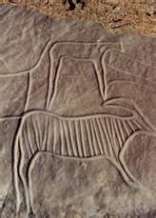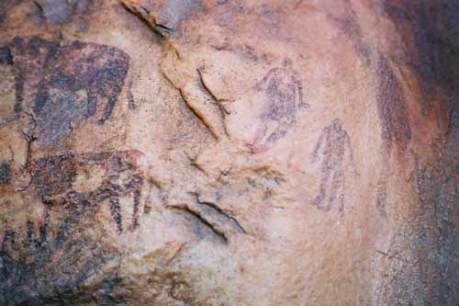Figurative images in Pre-Saharan Morocco before the 16th century
There are but few studies of the pre-historic period. It is difficult to date the earliest human presence in the region's valleys. Rock art accumulates along the wadis and in the southernmost region, viz. representations of chariots and humans near Taouz and Hassi Beraber. These archaeological findings do not allow for a precise identification of the peoples who lived there first. Djinn Jacques-Meunié sets forth three hypotheses: Black sedentary farmers, (ancestors to the Haratin still living in the regions); Berber nomads; both groups having used the same burial space either together or in turn. The drawings of animals found in Tawz and Oum el Aleg suggest they were created during a period when the climate was wetter than in the current regional situation of desertification: the presence of a herbivorous wild fauna is attested alongside that of herds of domesticated animals.




Besides the rock art at Fam El Hisn, tumuli the basis of which is built in bonded stone masonry are aplenty, in all shapes or forms from the simplest to the most elaborate. Some are tantamount to necropoleis for instance at Foum le-Rjam. The paintings found on the level of the funerary chambers consist essentially in human representations, horses (often in a combat context), weapons and undeciphered Libyco-Amazigh inscriptions: the people's hair is black, their clothing quite long. Here and there a background in red dots organised on a geometric pattern appears. Red and white prevail among the paint colours used. According to Djinn Jacques-Meunié the axis of the funereal chambers is often oriented East-West, with the deceased's head set South-East towards the aperture. A stone offerings table is often to be found erected by the tumulus.


The value of sites with inscriptions cannot be overstated, see for instance the obelisk of Aouesserd some 240 km south of Dakhla. It is a tumulus at the centre of which a funerary stele has been set; a fairly friable rectangular sandstone slab 40cm at its base rises to 3.5 meters, tapering towards the top. Its several faces have been engraved with a series of Libyc inscriptions, probably in memory of a dear departed [doc 19]. Local tradition has it that in the days of the Spanish occupation, the stele had been taken to a garden in Dakhla but as the people fell under a malediction, the authorities decided to return it to its original home. Its perambulations allegedly account for its degradations and wear and tear.






